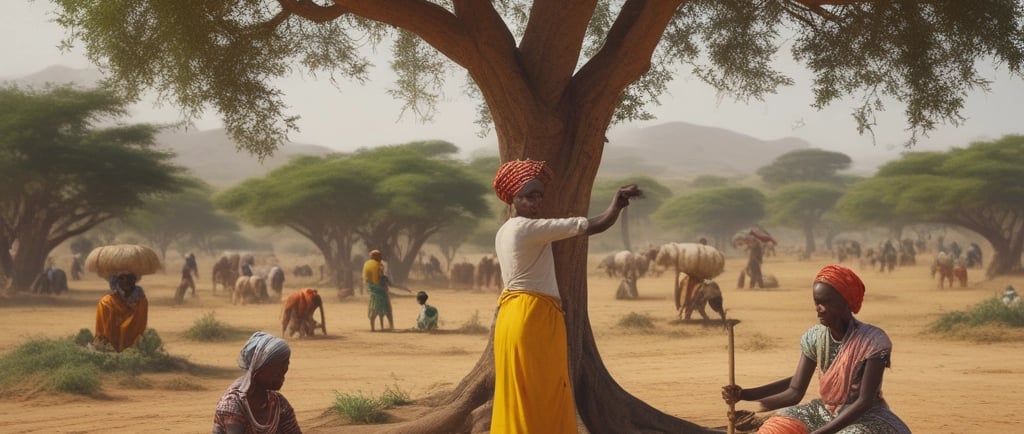afriads.io is live
Changing Behaviour- one day at a time
Walking and Learning
Mediatec.africa
7/5/20234 min read


It was clear that a change was needed, but how to implement it? This was the challenge that a group of passionate young locals faced, embarking on a journey of social behavior change communication (SBCC) to transform their community's agricultural practices. The team, comprising educators, local leaders, and health workers, understood that change would not come from merely instructing farmers on new techniques but through a well-crafted communication strategy that resonated with the villagers’ values and lifestyle. They began their project by conducting research, engaging with community members in open dialogues to understand their motivations, fears, and aspirations related to agriculture. Through community meetings, focus group discussions, and surveys, they discovered that many villagers felt a strong connection to their ancestors' farming practices. Any attempt to change these practices would need to respect this cultural heritage while gently persuading them to consider innovative methods. The task was daunting, but they were determined to bridge the gap between tradition and innovation. With insights gathered, the team designed a communication plan that would illuminate the benefits of modern farming techniques without undermining traditional values. They named the initiative "Roots and Shoots," symbolizing the connection between the deep roots of their heritage and the new growth of modern practices. This catchy title served as a rallying cry, uniting the community behind a common goal. The first phase of their initiative was to initiate open dialogues through storytelling—a powerful tool in their culture. The young team organized community gatherings around bonfires, where they invited elders to share stories of the past, intermingled with tales of successful sustainable practices from other regions. By weaving narratives that showcased how innovation could enhance their lives while preserving their culture, they fostered an environment of curiosity. At these gatherings, the team also introduced visual aids, such as illustrated brochures and infographics, depicting the benefits of crop rotation, organic fertilizers, and water conservation. These materials were intentionally designed to be visually engaging and easy to understand, ensuring they appealed to everyone, regardless of educational background. As excitement grew within the community, the next step was to offer practical demonstrations. The team set up a community garden where they showcased the new methods in action. The garden became a living example of how modern techniques could coexist harmoniously with traditional values. They invited local farmers to participate, allowing them to experience first-hand the advantages of the new methods without feeling threatened or overwhelmed. To maintain momentum and encourage continual engagement, the team established farmer support groups. These groups provided a platform for sharing experiences, challenges, and successes with the new agricultural techniques. By fostering peer-to-peer support, they created a community of practice where farmers could learn from one another in a nurturing environment. Additionally, they collaborated with local schools to introduce agricultural education into the curriculum, ensuring that future generations understood the importance of sustainable practices. This initiative encouraged kids to bring knowledge back to their families, facilitating intergenerational dialogue about farming methods. However, the journey was not without challenges. Some community members were resistant to change, voicing concerns that new methods might dilute their cultural identity. In response, the team organized workshops featuring local leaders who reinforced the message that modern practices could enhance, rather than replace, their traditions. By emphasizing stories of neighboring communities that successfully integrated new farming techniques without losing their identity, they began to shift perceptions. Slowly but surely, the tide began to turn. Farmers started to notice changes in their fields—better yields, healthier crops, and even improved soil health. The results, combined with the community’s enthusiasm for their new practices, inspired even the most skeptical to reconsider their stance. As the seasons changed, so too did the mindset of the villagers. Their initial wariness transformed into curiosity, and then excitement for what was possible. The culmination of the project came with the first harvest festival dedicated to the "Roots and Shoots" initiative. It became a community celebration, showcasing not only the fruits of their labor but also the unity the project created. With stalls filled with produce grown using new techniques, the event drew neighboring villages, inviting others to learn about their journey toward sustainable agriculture. During the festival, local musicians and artists contributed their talents, relating stories of farming innovation through their songs and performances. The successful integration of modern techniques into the community's fabric was now a celebration of culture—an acknowledgment that progress and tradition could coexist. The pride that radiated from the villagers was palpable, and they felt empowered, not only as farmers but as stewards of their land and culture. As the sun set over the hills, a local elder took the stage and spoke of the interconnectedness of community and environment, honoring both the past and the promise of the future. He highlighted how the "Roots and Shoots" initiative was more than just a collection of farming techniques; it was a movement embodying respect for their identity while embracing positive change. The initiative continued to grow, spawning offshoot projects focused on water conservation, pest management, and community health, all stemming from the principles of SBCC. The village, once at the brink of agricultural decline, had evolved into a beacon of sustainable practices and resilience. In reflecting on their journey, the team recognized the importance of humble beginnings. They understood that the seeds of change were sown through empathy, respect, and an unwavering commitment to fostering dialogue. The project taught them that sustainable behavior change is not just about imparting knowledge; it’s about nurturing a shared vision that resonates deep within the community’s heart and aligns with its collective aspirations. This tale of transformation in a small village serves as a testament to the power of social behavior change communication design and implementation. It illustrates that when communities come together, honoring their roots while welcoming new ideas, the potential for growth is limit
